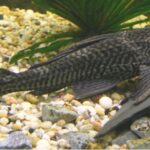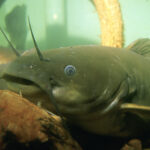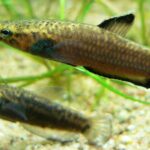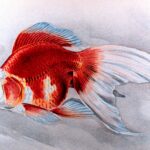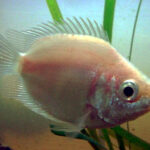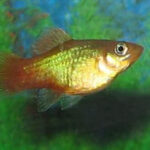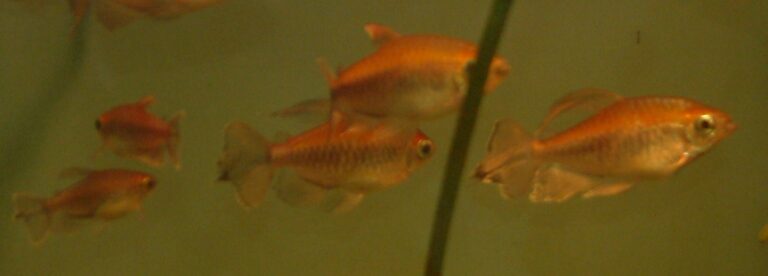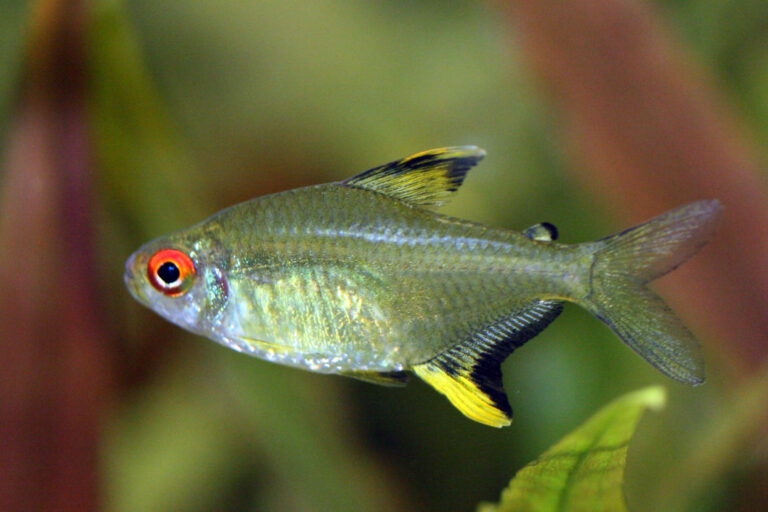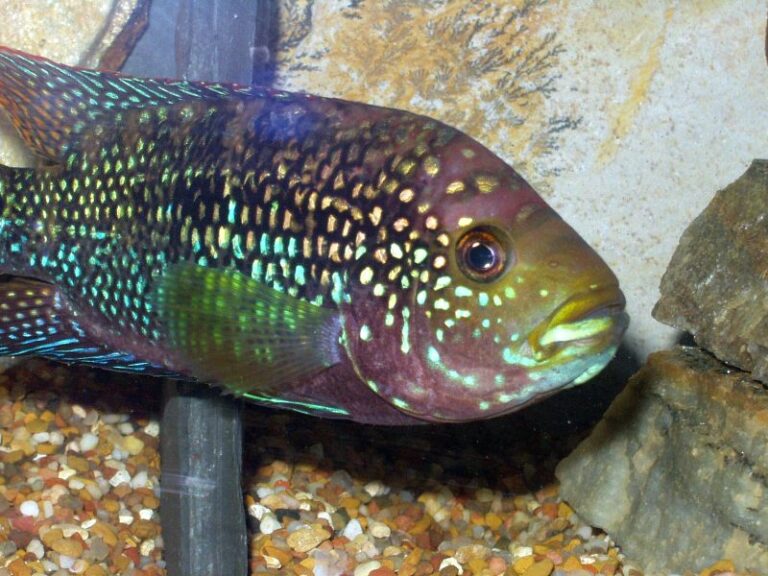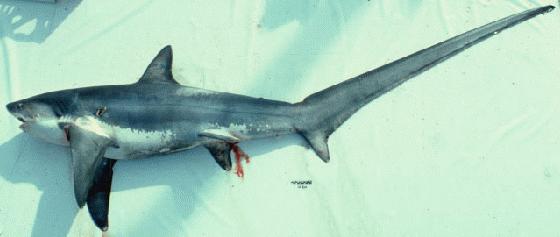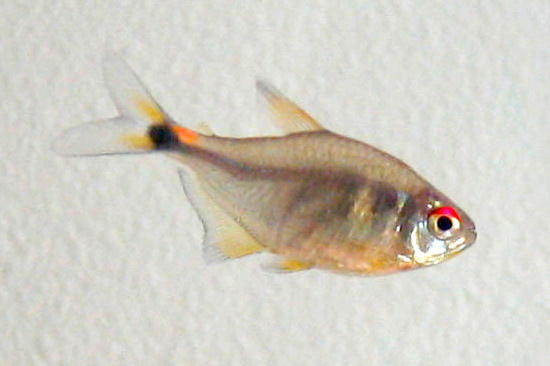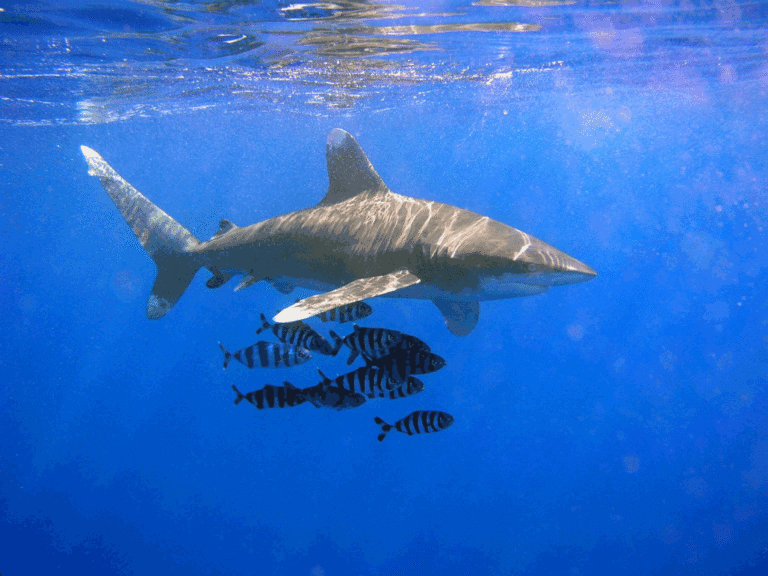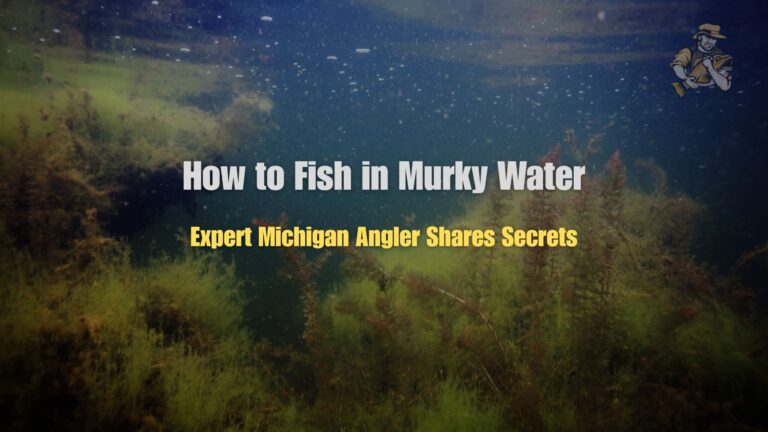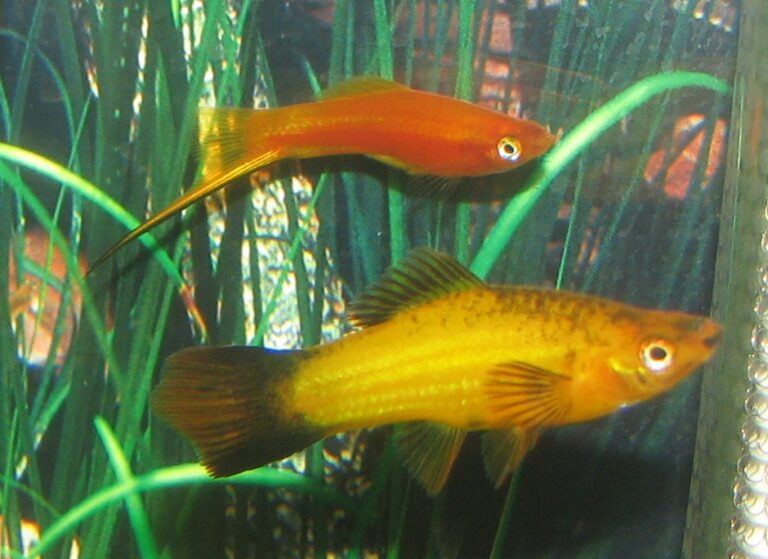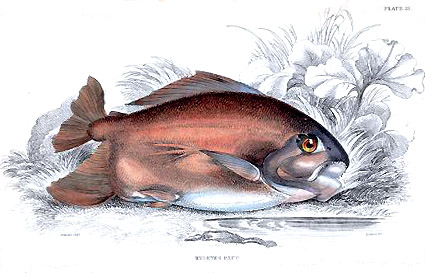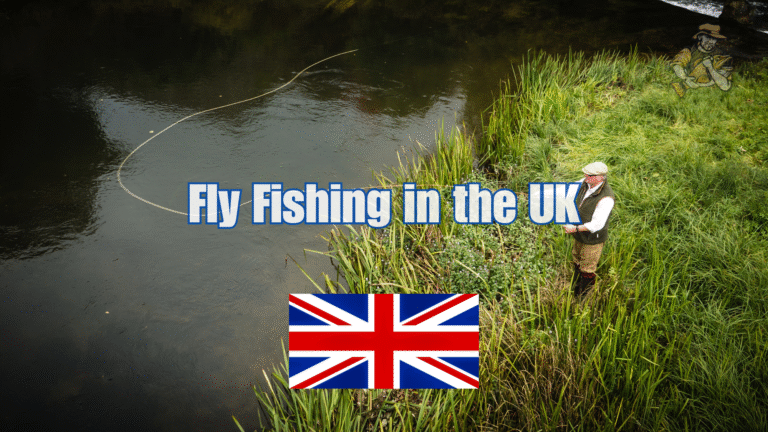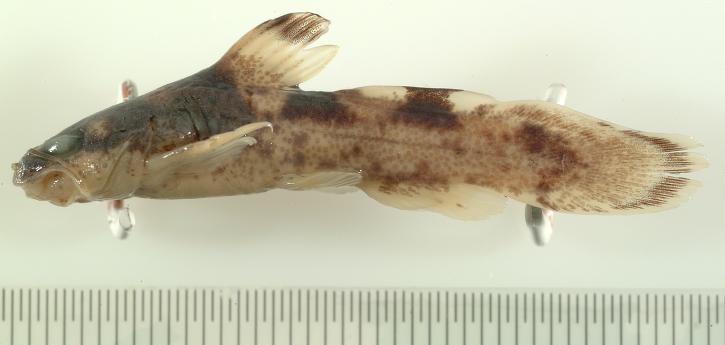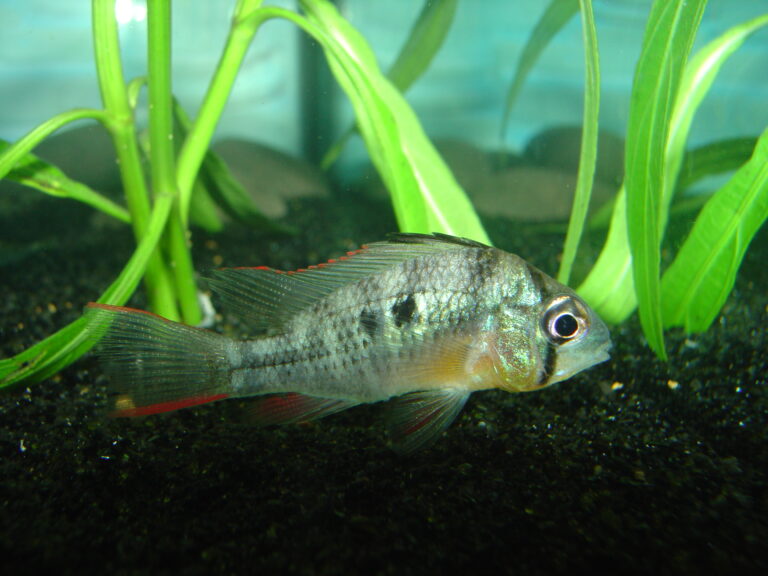Texas Cichlid
By Ryan Maron | Last Modified: June 9, 2025

The Texas Cichlid (Herichthys cyanoguttatus) stands as one of North America’s most distinctive freshwater fish species, representing the sole native cichlid of the United States. This robust fish species has captured the attention of both aquarium enthusiasts and ichthyologists due to its remarkable adaptability and striking appearance. Native to the Rio Grande drainage system, the Texas Cichlid plays a significant ecological role as both predator and prey within its freshwater habitat, contributing to the complex food webs of southern Texas and northeastern Mexico’s river systems.
The species demonstrates exceptional resilience in diverse aquatic environments, from slow-moving rivers to artificial reservoirs, making it an important indicator species for freshwater ecosystem health. Its territorial behavior and parental care strategies have made it a subject of extensive behavioral studies, while its popularity in the aquarium trade has introduced populations far beyond its native range.
| Feature | Details |
|---|---|
| Common Name | Texas Cichlid |
| Scientific Name | Herichthys cyanoguttatus |
| Family | Cichlidae |
| Typical Size | 20-30 cm (8-12 inches), 0.5-1.5 kg |
| Habitat | Freshwater rivers and reservoirs |
| Diet | Omnivorous opportunist |
| Distribution | Rio Grande basin, Texas to Mexico |
| Conservation Status | Least Concern |
Taxonomy & Classification
The Texas Cichlid belongs to the family Cichlidae, one of the largest vertebrate families with over 3,000 described species worldwide. Within this diverse family, Herichthys cyanoguttatus represents the genus Herichthys, which comprises several Central American cichlid species. The species was first scientifically described by Baird and Girard in 1854, making it one of the earlier documented North American cichlids.
Recent molecular phylogenetic studies have refined the understanding of Herichthys relationships, placing H. cyanoguttatus within a clade of closely related Mexican cichlids. The genus name Herichthys derives from Greek, meaning “separate fish,” while the specific epithet cyanoguttatus translates to “blue-spotted,” referencing the characteristic iridescent blue spots that adorn the species.
Taxonomic confusion has occasionally surrounded this species, with some populations previously classified under different genus names including Cichlasoma. Modern genetic analysis has confirmed the monophyletic nature of the Herichthys genus, solidifying the current classification. The Texas Cichlid shares common ancestry with other Rio Grande basin cichlids, representing an evolutionary lineage that colonized North American waters millions of years ago.
Physical Description
The Texas Cichlid exhibits remarkable sexual dimorphism and age-related color variations that make it one of the most visually striking freshwater fish in North America. Adult specimens typically reach lengths of 20 to 30 centimeters, with exceptional individuals occasionally exceeding 35 centimeters. The species displays a laterally compressed, oval body shape characteristic of many cichlid species, with a pronounced dorsal fin that extends along most of the back.
Coloration varies dramatically based on breeding condition, stress levels, and environmental factors. Non-breeding adults typically display a pearl-gray base color adorned with brilliant turquoise or blue spots scattered across the head, body, and fins. During spawning periods, both sexes intensify their coloration, with males developing deeper blues and prominent breeding tubercles on the head and gill covers.
The species possesses a terminal mouth equipped with pharyngeal teeth adapted for processing diverse food items. The dorsal fin contains both spiny and soft rays, with males often developing extended fin filaments during maturity. Juvenile Texas Cichlids appear markedly different from adults, displaying vertical dark bars across a lighter body that gradually fade as the fish matures.
Geographic variation exists within the species, with populations from different river systems showing subtle differences in spot patterns, body proportions, and maximum size. These variations likely reflect local adaptations to specific environmental conditions and prey availability.
Habitat & Distribution
The Texas Cichlid’s native range encompasses the Rio Grande drainage system, extending from south-central Texas through northeastern Mexico. This distribution makes it unique among North American fish fauna, as most cichlid diversity occurs in tropical regions of Africa and Central America. The species inhabits diverse freshwater environments including slow-moving rivers, oxbow lakes, irrigation canals, and large reservoirs.
Water temperature preferences range from 20 to 30 degrees Celsius, though the species demonstrates remarkable thermal tolerance, surviving brief exposure to temperatures outside this range. Texas Cichlids prefer areas with rocky or sandy substrates where they can establish territories and construct spawning sites. Vegetation provides important cover for juveniles, while adults often occupy open areas with scattered structure.
The species has established populations beyond its native range through both intentional introductions and aquarium releases. Notable established populations exist in Florida, where the species has colonized several river systems and canals. These introduced populations have raised concerns about potential impacts on native fish communities, particularly in sensitive ecosystems.
Habitat modification and water diversions have affected some native populations, though the species’ adaptability has allowed it to colonize artificial environments including reservoirs and irrigation systems. Climate change may potentially expand suitable habitat northward, though cold winter temperatures currently limit natural range expansion.
Diet & Feeding Behavior
The Texas Cichlid exhibits omnivorous feeding behavior with seasonal and size-related dietary shifts that reflect its opportunistic nature. Juvenile fish primarily consume small invertebrates including chironomid larvae, copepods, and other zooplankton. As they mature, their diet expands to include larger prey items such as crayfish, small fish, aquatic insects, and plant material.
Adult Texas Cichlids demonstrate remarkable feeding flexibility, adjusting their diet based on seasonal prey availability. During summer months when invertebrate populations peak, they focus heavily on crayfish, snails, and aquatic worms. Winter feeding shifts toward available fish species and detrital material. The species’ pharyngeal teeth allow efficient processing of hard-shelled prey like mollusks and crustaceans.
Foraging behavior includes both active hunting and opportunistic feeding. Texas Cichlids often excavate substrate to uncover buried invertebrates, creating small craters that can modify benthic habitat structure. This substrate manipulation behavior influences local ecosystem dynamics by affecting sediment composition and invertebrate distribution patterns.
Seasonal feeding intensity varies with reproductive cycles and water temperature. Pre-spawning adults increase feeding rates to build energy reserves, while parental fish may reduce feeding during intensive brood care periods. The species’ broad dietary flexibility contributes significantly to its success in diverse habitats and introduced environments.
Behavior & Adaptations
Texas Cichlids exhibit complex behavioral patterns centered around territorial defense, reproductive activities, and social hierarchies. Adult fish establish and defend territories year-round, with territory size varying based on habitat quality, population density, and individual size. Territorial boundaries are maintained through visual displays, aggressive posturing, and direct confrontation when necessary.
The species demonstrates sophisticated communication through body coloration changes, fin positioning, and behavioral displays. Dominant individuals often display intensified coloration and erect fins while subordinate fish adopt pale coloration and submissive postures. These visual signals help maintain social hierarchies and reduce physical conflicts within populations.
Parental care represents one of the most remarkable aspects of Texas Cichlid behavior. Both parents participate in nest preparation, egg care, and fry protection, showing highly developed biparental care strategies rare among North American freshwater fish. Parents will aggressively defend their offspring against potential predators, including fish many times their size.
The species shows considerable behavioral plasticity in response to environmental conditions. In high-density situations, Texas Cichlids may modify their territorial behavior and adopt more tolerant social interactions. This behavioral flexibility contributes to their success in diverse habitats and changing environmental conditions.
Seasonal behavioral changes include breeding migrations to suitable spawning areas and aggregation behaviors during winter months when fish concentrate in deeper, more stable habitats. These behavioral adaptations enhance survival and reproductive success across variable environmental conditions.
Reproduction & Life Cycle
The reproductive biology of the Texas Cichlid showcases sophisticated breeding behaviors and extended parental care that distinguish it from most North American freshwater fish species. Breeding typically occurs from late spring through early fall, with peak spawning activity during warmer months when water temperatures exceed 24 degrees Celsius.
Pair formation involves elaborate courtship rituals where potential mates assess each other through displays of coloration, fin erection, and synchronized movements. Once paired, both sexes collaborate in selecting and preparing nest sites, typically choosing flat rocks, sandy depressions, or artificial structures in shallow water areas with moderate current flow.
Females deposit 500 to 2,000 adhesive eggs depending on their size and condition, with larger females producing significantly more offspring. Males immediately fertilize the eggs, and both parents begin intensive nest defense and care behaviors. Incubation lasts 3 to 5 days depending on water temperature, during which parents fan the eggs with their fins and remove dead or fungused eggs.
After hatching, larvae remain attached to the substrate for several days while absorbing their yolk sacs. Parents then move the fry to pre-prepared nursery areas, often shallow depressions excavated in sandy substrate. The fry school tightly around their parents for 4 to 6 weeks, receiving protection and guidance to feeding areas.
Parental care extends well beyond initial fry development, with some family groups remaining together for several months. This extended care significantly improves offspring survival rates compared to fish species that provide no parental protection. Sexual maturity occurs at approximately 12 to 18 months of age, though optimal breeding condition may not develop until the second or third year.
Predators & Threats
Adult Texas Cichlids face relatively few natural predators due to their size, aggressive nature, and defensive capabilities, though several species pose threats throughout their life cycle. Large predatory fish including gar species, large bass, and catfish occasionally prey upon adult cichlids, particularly during vulnerable periods such as spawning when territorial behavior may expose them to increased predation risk.
Juvenile Texas Cichlids face significantly higher predation pressure from diverse aquatic predators including herons, egrets, and other wading birds that frequent shallow spawning and nursery areas. Aquatic predators such as bass, pike, and other cichlids readily consume young fish despite parental protection efforts. Invertebrate predators including large crayfish and aquatic insects also impact egg and larval survival rates.
Human activities represent the primary threat to Texas Cichlid populations throughout their native range. Water diversions for agricultural and municipal use have significantly altered flow regimes in many river systems, reducing available spawning habitat and fragmenting populations. Pollution from agricultural runoff, urban development, and industrial activities degrades water quality and reduces prey availability.
Habitat modification through channelization, dam construction, and riparian development has eliminated critical spawning areas and altered natural flow patterns essential for successful reproduction. Climate change poses emerging threats through altered precipitation patterns, increased drought frequency, and rising water temperatures that may exceed tolerance limits during extreme weather events.
In introduced ranges, Texas Cichlids may face different predator assemblages and competitive pressures than in their native habitat. However, their aggressive nature and adaptability often allow them to establish successful populations even in environments with novel predators and competitors.
Conservation Status
The Texas Cichlid currently maintains a conservation status of Least Concern according to the International Union for Conservation of Nature (IUCN), though regional population trends show concerning declines in some areas of the native range. The species’ overall stability reflects its adaptability to diverse habitats and tolerance of environmental disturbances that affect more sensitive species.
Within Texas, state wildlife agencies monitor Texas Cichlid populations as part of broader freshwater fish community assessments. Some river systems have experienced population declines attributed to habitat modification, water diversions, and prolonged drought periods. The Edwards Aquifer region, historically supporting robust populations, has seen reduced cichlid abundance during extended dry periods.
Conservation efforts focus primarily on habitat protection and restoration rather than direct species management. Maintaining minimum environmental flows in regulated river systems benefits Texas Cichlids along with entire aquatic communities. Riparian restoration projects that stabilize stream banks and provide overhead cover create improved habitat conditions for all life stages.
The species’ establishment in non-native ranges presents a complex conservation challenge. While introduced populations may serve as insurance against native range declines, they potentially impact native fish communities through competition and predation. Management approaches vary by region, with some areas implementing control measures while others monitor impacts on native species.
Research priorities include population genetics studies to understand connectivity between fragmented native populations and long-term monitoring to detect climate change impacts. Collaborative efforts between academic institutions, government agencies, and conservation organizations continue to advance understanding of Texas Cichlid ecology and conservation needs.
Human Interaction
The relationship between humans and Texas Cichlids encompasses recreational fishing, aquarium keeping, and ecological management considerations that reflect the species’ unique position as North America’s only native cichlid. Sport fishing for Texas Cichlids has developed a dedicated following among anglers seeking unique freshwater challenges, with the species’ aggressive strikes and strong fighting ability making it a prized catch.
Angling techniques for Texas Cichlids often mirror bass fishing strategies, including the use of crayfish-imitating lures, small spinnerbaits, and live bait presentations. The species readily takes artificial lures, making it accessible to various fishing skill levels. Some Texas reservoirs have developed reputations as premier Texas Cichlid fishing destinations, attracting anglers from across the region.
In the aquarium trade, Texas Cichlids command significant interest among cichlid enthusiasts who appreciate their stunning coloration and complex behaviors. However, their large adult size, aggressive nature, and specific care requirements make them suitable only for experienced aquarists with appropriate tank setups. Responsible aquarium keeping practices are essential to prevent releases that could establish new invasive populations.
Educational value extends beyond recreational pursuits, as Texas Cichlids serve as excellent subjects for studying cichlid behavior, parental care, and freshwater ecology. University research programs and public aquariums often maintain Texas Cichlid populations for educational and research purposes, contributing to broader understanding of cichlid biology.
Management considerations include balancing conservation of native populations with control of introduced populations where they may impact native species. Public education about responsible aquarium practices and the importance of native fish conservation helps promote coexistence between human interests and ecological health.
Interesting Facts
The Texas Cichlid holds the distinction of being the northernmost naturally occurring cichlid species in the world, representing a remarkable biogeographical anomaly in a family predominantly associated with tropical regions. This unique position makes it an important species for understanding cichlid evolution and adaptation to temperate climates.
Remarkable parental dedication sets Texas Cichlids apart from most North American fish species, with documented cases of parents defending their young against predators many times their size, including large bass and even wading birds. Some observations record parent fish successfully driving away predators exceeding three feet in length through coordinated attacks and persistent harassment.
The species demonstrates sophisticated problem-solving abilities rarely observed in freshwater fish. Texas Cichlids have been observed using tools, manipulating substrate to create barriers around their nests, and even appearing to “plan” complex territorial arrangements that maximize breeding success while minimizing conflicts with neighbors.
Color-changing abilities rival those of marine fish species, with Texas Cichlids capable of dramatically altering their coloration within seconds in response to social situations, environmental changes, or emotional states. Breeding males can shift from pale gray to brilliant blue and gold combinations that create stunning visual displays.
Archaeological evidence suggests that Texas Cichlids may have served as a food source for Native American populations along the Rio Grande, with cichlid remains found in ancient midden sites throughout south Texas. This historical relationship highlights the species’ long-standing importance to human communities in the region.
The species exhibits remarkable longevity for a freshwater fish of its size, with documented individuals reaching ages exceeding 15 years in captivity. This longevity, combined with their complex social behaviors, allows for the development of learned behaviors and recognition of individual humans in aquarium settings.
Frequently Asked Questions
Can Texas Cichlids survive in cold water environments?
Texas Cichlids have limited cold tolerance compared to native North American fish species. They can survive brief exposure to temperatures as low as 10 degrees Celsius but require water temperatures above 15 degrees Celsius for long-term survival. Prolonged exposure to temperatures below this threshold typically proves fatal, which naturally limits their range expansion into northern regions.
Are Texas Cichlids suitable for community aquariums?
Texas Cichlids are generally not recommended for community aquariums due to their aggressive territorial nature and large adult size. They require species-specific setups or carefully selected tankmates of similar size and temperament. Their complex social behaviors and high bioload also demand experienced aquarium management and appropriate filtration systems.
How do Texas Cichlids impact native fish populations in introduced areas?
In introduced environments, Texas Cichlids can potentially compete with native species for food and spawning habitat. Their aggressive nature and efficient predation on small fish and invertebrates may reduce populations of native species, though comprehensive impact studies remain limited. The extent of ecological impact varies significantly based on local environmental conditions and native species composition.
What distinguishes Texas Cichlid parental care from other North American fish species?
Texas Cichlids provide biparental care that extends for weeks or months after hatching, a behavior extremely rare among North American freshwater fish. Both parents actively defend territories, prepare nursery sites, and guide fry to feeding areas. This intensive care system results in significantly higher offspring survival rates compared to species that provide no parental protection after spawning.
Conclusion
The Texas Cichlid represents a remarkable example of cichlid adaptation to North American freshwater environments, serving as both an ecological keystone species and a unique component of regional biodiversity. Its complex behaviors, striking appearance, and evolutionary significance make it an invaluable subject for scientific study and conservation efforts. As human activities continue to alter aquatic habitats throughout its range, protecting Texas Cichlid populations becomes increasingly important for maintaining the ecological integrity of southwestern freshwater systems and preserving North America’s sole native cichlid for future generations.
Share The Article:
More Fish Species:
-
Congo Tetra
The Congo Tetra stands as one of Africa’s most remarkable freshwater fish species, captivating aquarists and ichthyologists alike with…
-
Siamese Fighting Fish
The Siamese Fighting Fish, scientifically known as *Betta splendens*, stands as one of the most recognizable and culturally significant…
-
Lemon Tetra
The Lemon Tetra (*Hyphessobrycon pulchripinnis*) stands as one of South America’s most vibrant freshwater fish species, distinguished by its…
-
Jack Dempsey Fish
The Jack Dempsey Fish stands as one of Central America’s most distinctive cichlid species, captivating aquarists and researchers alike…
-
Thresher Shark
The Thresher Shark represents one of the ocean’s most distinctive and captivating apex predators, renowned for its extraordinarily elongated…
-
Head and Tail Light Tetra
The Head and Tail Light Tetra (*Hemigrammus ocellifer*) stands as one of South America’s most distinctive characin species, instantly…
Discover
-
North Jersey Fishing Guide: Best Lakes, Rivers & Seasons
If you’ve never experienced the fishing in North Jersey, you’re missing out on some genuinely underrated angling opportunities. From…
-
Alaska Salmon Fishing: Planning Your Trip to the Last Frontier
I still remember the first time I hooked into a Kenai River king salmon. It was July 15, 2019,…
-
How to Use a Spinnerbait: Complete Guide for Beginners
In my three decades of fishing experience, I’ve found few lures as versatile and effective as the humble spinnerbait….
-
Oceanic Whitetip Shark
The Oceanic Whitetip Shark (*Carcharhinus longimanus*) stands as one of the ocean’s most formidable and recognizable apex predators, distinguished…
-
How to Fish in Murky Water: Expert Michigan Angler Shares Secrets
Last Tuesday, I was standing knee-deep in chocolate-colored water where Kellogg Creek dumps into the Kalamazoo River. Water visibility:…
-
Caribbean Inshore Fishing: Bonefish and Permit Tactics
There’s something almost magical about stalking the shallow flats of the Caribbean. I still remember my first bonefish –…
Discover
-
Swordtail Fish
The Swordtail Fish (Xiphophorus hellerii) stands as one of the most recognizable and beloved species in the aquarium trade,…
-
Pelagic Thresher Shark
The Pelagic Thresher Shark stands as one of the ocean’s most distinctive and efficient predators, renowned for its dramatically…
-
Pacu Fish
Pacu fish represent one of South America’s most ecologically significant freshwater species, encompassing several closely related members of the…
-
Fly Fishing in the UK: Top Rivers and Seasonal Patterns
After nearly three decades casting flies across waters from Michigan to Maine – and now spending several weeks each…
-
Madtom Catfish
The Madtom Catfish represents one of North America’s most fascinating yet underappreciated groups of freshwater fish. These diminutive members…
-
Bolivian Ram
The Bolivian Ram (Mikrogeophagus altispinosus) stands as one of South America’s most captivating cichlid species, representing a prime example…

